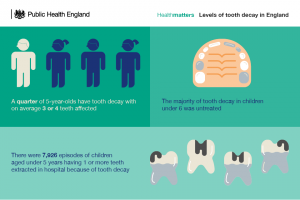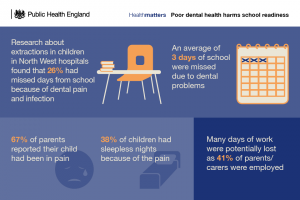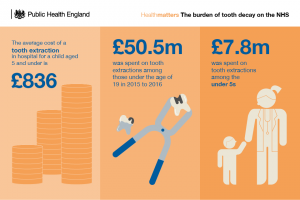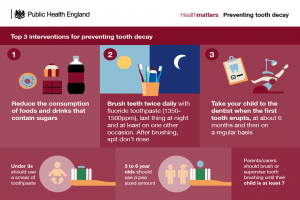25 / 05 / 2023
The Dental Health Of Our Children – The Reality
Oral health is part of general health and wellbeing and contributes to the development of a healthy child and school readiness.
Tooth decay is the most common oral disease affecting children and young people in England, yet it is largely preventable.

Although oral health is improving in England almost a quarter (24.7%) of 5 year olds have tooth decay, so 1 in 4 children will have tooth decay when they start school. Each child with tooth decay will have on average 3 to 4 teeth affected.
The first survey of 3 year olds found that 12% had visible dental decay with on average 3 teeth affected. Tooth decay was the most common reason for hospital admission for children aged 5 to 9 years in 2012 to 2013. Over 63,000 children aged 0 to 19 years were admitted to hospital for tooth extractions in 2014 to 2015.

Poor oral health impacts on children and families wellbeing and is costly to treat. It suggests wider health and social care issues such as poor nutrition, obesity, the need for parenting support, and in some instances safeguarding and neglect. Children who have toothache or who need treatment may have to be absent from school. Parents may also have to take time off work to take their children to the dentist. Dental treatment is a significant cost, with the NHS in England spending £3.4 billion per year on all ages primary and secondary dental care (with an estimated additional £2.3 billion on private dental care).

Children who experience high levels of disease that are treated with fillings and other restorations will require complex maintenance as they age. Those children with a poor oral health regime and unrestricted dietary habits will fare the worst and have treatment which not only maintains their historic decay and poor oral health but also require treatment of new oral problems as they age.
Risk factors
Poor oral health can be caused by many factors including:
- social inequalities where the imbalance in income, education, employment and neighbourhood circumstances affect the life chances of children’s development
- poor nutrition and infant feeding with high and frequent consumption of free sugars
- lack of access to fluoride including late commencing or infrequent tooth brushing with low or no fluoride toothpaste

Other risks are children:
- who already have evidence of oral disease including previous decay experience or previous extractions under general anaesthesia
- with medical conditions such as cardiac problems, cleft lip and palate and childhood cancers
- Regularly consuming foods and drinks high in free sugars increases the risk of obesity and tooth decay. Ideally, no more than 5% of the energy we consume should come from free sugars. Currently, children and adults across the UK are consuming 2 to 3 times that amount. Sugary drinks have no place in a child’s daily diet but account for a surprisingly large proportion of the daily free sugar intake of both children and adults. Almost a third of the free sugars consumed by 11 to 18 year olds come from soft drinks.
Facts about oral health
- Although largely preventable, tooth decay remains the most common oral disease affecting children and young people.
- In 2015, 20% of 5 year olds had tooth decay in South East England compared to 34% in North West England with even greater inequalities within local authorities. Areas with higher levels of deprivation tend to have higher levels of tooth decay.
- 5.6% of 5 year old children in England had tooth decay in their incisor (front) teeth in 2015. This measure is useful as it indicates where children have been affected by a particular type of tooth decay. This is an aggressive form of decay that affects upper incisors and can be rapid and extensive in attack. It is associated with long term bottle use with sugar-sweetened drinks, especially when these are given overnight or for long periods of the day.
- A recent survey of 3 year olds in England found that 12% had tooth decay ranging from 34% to 2% across local authority areas.
- During 2014 to 2015, there were 33,871 cases of children aged 10 and under needing the removal of one or more teeth: a rise of 3% on the previous year.
- Tooth decay was the most common reason for hospital admissions in children aged 5 to 9 years old in 2013 to 14.
- In 2014 to 2015, hospital trusts spent £35 million on the extraction of multiple teeth for under 18s.






